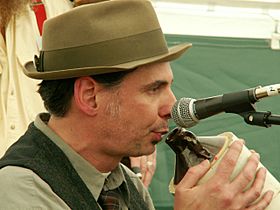Jug (instrument) facts for kids
A musical jug is an empty jug, often made of glass or stoneware. People play it by buzzing their lips into the opening. This creates a sound similar to a trombone. The jug makes a low, deep, and sometimes rough sound. It usually provides the bass notes in a band. This unique sound helps the jug stand out from other instruments like the fiddle or harmonica.
How to Play a Musical Jug
Playing the jug is a bit like playing a brass instrument. The musician holds the jug opening about an inch from their mouth. They buzz their lips, sending air directly into the jug. The jug itself doesn't touch the player's mouth. Instead, it acts like a special echo chamber. This chamber makes the sound from the player's lips much louder and richer.
Players change the sound's pitch by making their lips tighter or looser. A skilled jug player can make many different notes. Some players even add vocal sounds or use a technique called circular breathing. This lets them play for a long time without stopping for breath. For the best sound, players often stand with their back to a wall. This helps the sound bounce towards the audience.
Some musicians also play a "stovepipe" in a similar way. This is usually a metal pipe. Like the jug, the pipe acts as a resonating chamber.
The Jug's Role in a Band
The musical jug is a bass instrument. This means it plays the low notes in a band. It's an important part of the band's rhythm section. The rhythm section helps keep the beat and provides the musical foundation. Even though it's a bass instrument, jug solos are quite common. Most jug bands have one jug player. However, some old recordings show bands with two or more jug players.
You can also make a sound by blowing air across the top opening of a jug. This makes a single whistling sound. However, this method is usually too quiet for bands. It's more often used to make glass bottles whistle. Larger bottles make lower sounds, while smaller ones make higher sounds. You can change the pitch by adding or removing liquid from the bottle.
History of the Musical Jug
The musical jug became very popular in the 1920s. This was when jug bands were common. Bands like Cannon's Jug Stompers were famous. The jug was popular because it was cheap and easy to carry around.
People have used many different materials for musical jugs. These include glass jugs, plastic bottles, and even tin cans. Each material and size makes a slightly different sound. The jug is usually an acoustic instrument. This means it doesn't need electricity to make sound. However, some musicians have used amplified or "electric jugs." For example, Tommy Hall used one in the 1960s band 13th Floor Elevators.
An older version of the jug, called the botija, was played in early Cuban music. It was part of musical styles like the son.
In more recent times, Fritz Richmond (1939–2005) was a well-known jug player. You can hear his playing on many recordings. Josh Smith, born in 1979, is another famous jug player today. He plays with the Glade City Rounders. Some experts say he is one of the best jug players around.


